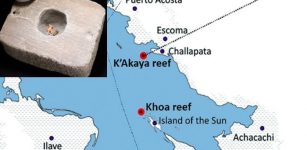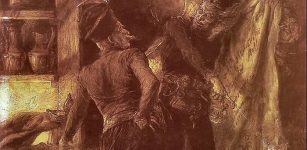Cornucopia – ‘Horn Of Plenty’ – Ancient Symbol And Its Almost Forgotten Meaning
A. Sutherland - AncientPages.com - A cornucopia (from Latin 'cornu copiae') - horn of plenty ) is often depicted in paintings and on friezes. It is a hollow horn-shaped container filled with abundant fruit, coins, flowers, grain, nuts, or any other desirable things.
 A woman holding a cornucopia. Public Domain
A woman holding a cornucopia. Public Domain
It is an ancient symbol of boundless abundance.
Many of us have a cornucopia at home; it can be made of plastic, wicker, metal, wood, or other materials. It can be symbolically filled with something valuable or simply beautiful.
Cornucopia – a horn of plenty – symbolizes wealth, abundance, fertility, and nourishment. It is highly respected by many ancient cultures, including the Celts, whose concept of abundance was central to their religion.
Initially, it represents a mythical symbol originating from the Mediterranean region of Europe. In North America, the cornucopia is associated with the country's great tradition of Thanksgiving, dating back to the Protestant Reformation in 16th-century Europe but the symbol of cornucopia dates back to very ancient times.
Popular Versions Of Cornucopia's Origin
Several mythological explanations suggest the origin of the cornucopia, some of which date back to the 5th century BC. Two of them are believed to be the most popular.
Left: Fortuna, the goddess of good luck, was given the power to bring prosperity to a human being and her attribute is a cornucopia - horn of plenty. Image credit: Vatican, Rome, Italy. Statue of Fortune. Brooklyn Museum; Right: Angel with the horn of plenty. Image credit: Wolfgang Sauber/Wikipedia
According to a version in Greek mythology, the cornucopia belonged to the goat Amalthea ("Nourishing Goddess"), who protected and raised the infant Zeus, who, even as a little boy, had enough strength to break off one of Amalthea's horns while playing. The horn then had the divine power to fill up with everything the owner wanted.
This mythological horn is known as the horn of plenty (cornucopia), and its tradition continues today.
In another myth, the cornucopia was created during one of Heracles' (Roman Hercules) missions to fight with the river god Achelous. During their encounter, Heracles broke off one of his horns.
Gods And Goddesses Were Often Depicted With Cornucopia
The cornucopia became the attribute of several Greek and Roman deities, particularly those associated with prosperity, harvest, or spiritual abundance.
Hades (right-hand side) with a cornucopia and Persephone (left-hand side). Detail from an Attic red-figure amphora, ca. 470 BC. Image credit: Jastrow - CC BY 3.0
Erecura (Aerecura), a goddess often considered Celtic in origin, was often depicted with attributes of fertility as the cornucopia and apple baskets. Also, Epona is associated with cornucopia, Dionysus, and Hades, the god of the underworld and ruler of the dead, who, as Plouton (or Pluto), is a bringer of agricultural, mineral, and spiritual wealth.
In ancient Roman religion, Abundantia was a divine personification of prosperity and abundance. She was often depicted with a cornucopia like the Roman goddess of peace, Pax, who cared for peace (Pax Romana) and wealth and had attributes like an olive branch and a horn of plenty.
Ancient sources confirm that the cornucopia or some versions were found on seals and buildings and imprinted in Jewish coins during the Maccabean times.
A Symbol Of Cornucopia In Ancient Egypt
The cornucopia was also an important symbol for ancient Egyptians.
 Cornucopia in the Statue of Flora in Szczecin, Poland. Image credit: Remigiusz Józefowicz - CC BY-SA 2.5 pl
Cornucopia in the Statue of Flora in Szczecin, Poland. Image credit: Remigiusz Józefowicz - CC BY-SA 2.5 pl
"Horus the Child (the Greek Harpocrates, the god of silence and confidentiality) was one of the best-loved. In the early centuries of the Christian era, he was depicted as a child, sometimes seated in a lotus blossom, a ship, or enthroned as a follower of the sun god. Frequently he carries a cornucopia or a jar…' Lewis Spence writes in his book 'Ancient Egyptian Myths and Legends.'
The legendary Cleopatra VII, the last active ruler of the Ptolemaic Kingdom of Egypt, struck several series of silver coins at the mint in Askalon. On one side of these coins, there is her portrait, and on the reverse (back), Ptolemaic coins have exceptionally only a few motifs; one of them is particularly popular (more than 95 percent) and shows a symbol of a cornucopia (on gold coins).
The cornucopia is still a popular decorative motif, although the symbol's very ancient sacred meaning has long been forgotten.
Written by – A. Sutherland - AncientPages.com Senior Staff Writer
Updated on April 3, 2023
Copyright © AncientPages.com All rights reserved. This material may not be published, broadcast, rewritten or redistributed in whole or part without the express written permission of AncientPages.com
Expand for referencesReferences:
Harrison J. E. Themis: A Study of the Social Origins of Greek Religion
Spence L. Ancient Egyptian Myths and Legends
More From Ancient Pages
-
 Mysterious Jawbone May Represent Earliest Presence Of Humans In Europe
Archaeology | Dec 7, 2022
Mysterious Jawbone May Represent Earliest Presence Of Humans In Europe
Archaeology | Dec 7, 2022 -
 Stone Box With Ancient Shell Llama Offering Found In Lake Titicaca
Archaeology | Aug 4, 2020
Stone Box With Ancient Shell Llama Offering Found In Lake Titicaca
Archaeology | Aug 4, 2020 -
 Cryptic North American Blythe Intaglios Reveal The Creator Of Life: Who Was This Unknown Being?
Featured Stories | Aug 23, 2014
Cryptic North American Blythe Intaglios Reveal The Creator Of Life: Who Was This Unknown Being?
Featured Stories | Aug 23, 2014 -
 Secret Hidden Freemasonic Messages Concealed In Ancient Egyptian Artifacts And Roman Works – A Misunderstood Object? – Part 1
Ancient Mysteries | Feb 18, 2022
Secret Hidden Freemasonic Messages Concealed In Ancient Egyptian Artifacts And Roman Works – A Misunderstood Object? – Part 1
Ancient Mysteries | Feb 18, 2022 -
 Skidi Pawnee Indians: One Of The Most Proficient Astronomers Of Ancient Times And Their Sophisticated Star Chart
Featured Stories | Nov 28, 2024
Skidi Pawnee Indians: One Of The Most Proficient Astronomers Of Ancient Times And Their Sophisticated Star Chart
Featured Stories | Nov 28, 2024 -
 Pan Twardowski – The Man Who Sold His Soul To The Devil In Exchange For Special Powers
Featured Stories | Aug 12, 2021
Pan Twardowski – The Man Who Sold His Soul To The Devil In Exchange For Special Powers
Featured Stories | Aug 12, 2021 -
 Rare Ancient Underwater Maya Ruins And Salt Kitchens Discovered
Archaeology | Oct 13, 2022
Rare Ancient Underwater Maya Ruins And Salt Kitchens Discovered
Archaeology | Oct 13, 2022 -
 Giants Of The Jurassic Seas Were Twice The Size Of A Killer Whale – New Study
Fossils | May 11, 2023
Giants Of The Jurassic Seas Were Twice The Size Of A Killer Whale – New Study
Fossils | May 11, 2023 -
 Royal Game Of Ur – One Of The Oldest Game Boards Discovered
Ancient History Facts | Feb 3, 2016
Royal Game Of Ur – One Of The Oldest Game Boards Discovered
Ancient History Facts | Feb 3, 2016 -
 Louhi – Witch Goddess Of The North And The Magical Artifact Sampo In Finnish Mythology
Featured Stories | Sep 21, 2017
Louhi – Witch Goddess Of The North And The Magical Artifact Sampo In Finnish Mythology
Featured Stories | Sep 21, 2017 -
 1.8-Million-Year-Old Human Tooth Found In Georgia Offers More Information On Prehistoric Human Migrations
Archaeology | Sep 15, 2022
1.8-Million-Year-Old Human Tooth Found In Georgia Offers More Information On Prehistoric Human Migrations
Archaeology | Sep 15, 2022 -
 Bezvodovka: Little Known Ancient Solar Observatory In Ukraine Reveals Its Secrets
Archaeoastronomy | Jan 4, 2017
Bezvodovka: Little Known Ancient Solar Observatory In Ukraine Reveals Its Secrets
Archaeoastronomy | Jan 4, 2017 -
 Romans Were Early Pioneers Of Recycling – New Evidence Reveals
Archaeology | Oct 17, 2023
Romans Were Early Pioneers Of Recycling – New Evidence Reveals
Archaeology | Oct 17, 2023 -
 New Light On The Complex Evolution Of Our Feet
Evolution | Nov 22, 2023
New Light On The Complex Evolution Of Our Feet
Evolution | Nov 22, 2023 -
 Nabataean Culture Lived On Long After Their Kingdom Disappeared – New Evidence
Archaeology | Feb 27, 2019
Nabataean Culture Lived On Long After Their Kingdom Disappeared – New Evidence
Archaeology | Feb 27, 2019 -
 Largest Capstone Ever Found In South India
Archaeology | Mar 24, 2017
Largest Capstone Ever Found In South India
Archaeology | Mar 24, 2017 -
 1.5-Million-Year-Old Footprints Of Two Different Species Of Human Ancestors Found At The Same Spot
Human Beginnings | Nov 29, 2024
1.5-Million-Year-Old Footprints Of Two Different Species Of Human Ancestors Found At The Same Spot
Human Beginnings | Nov 29, 2024 -
 Unique, Well-Preserved 4,000-Year-Old Boat Discovered Near The Ancient City Of Uruk
Archaeology | Apr 4, 2022
Unique, Well-Preserved 4,000-Year-Old Boat Discovered Near The Ancient City Of Uruk
Archaeology | Apr 4, 2022 -
 Secrets Of Mount Shasta – One Of The Most Sacred Places On Earth
Ancient Mysteries | Oct 24, 2015
Secrets Of Mount Shasta – One Of The Most Sacred Places On Earth
Ancient Mysteries | Oct 24, 2015 -
 Nobel Prize: Svante Pääbo’s Ancient DNA Discoveries Offer Clues As To What Makes Us Human
DNA | Oct 12, 2022
Nobel Prize: Svante Pääbo’s Ancient DNA Discoveries Offer Clues As To What Makes Us Human
DNA | Oct 12, 2022


